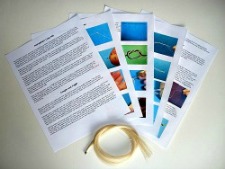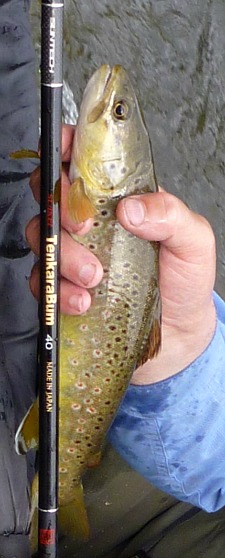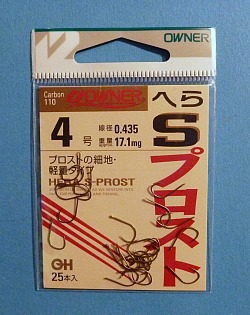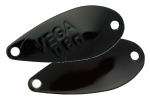Trip Report - 2-28-18
The reason I haven't filed many trip reports lately is a combination of "nothing to write home about" and "if you don't have something nice to say, don't say anything." Winter fishing is usually not very productive for me, and this winter has been no exception.
Presented with a February thaw, though, I just had to get out and wet a line. It was a fairly slow day so I got all the packages to the Post Office by 1 o'clock, packed up a bit of gear and headed to Central Park. Central Park is not my favorite place to fish, but if I only have a few hours it's the most logical choice.
 The Harlem Meer in Central Park
The Harlem Meer in Central ParkSeveral years ago I messed around a bit with fishing multiple flies, as is the custom in pesca a mosca Valsesiana. For those who are not familiar with it, pesca a mosca Valsesiana is an Italian traditional fly fishing method that is quite similar to tenkara in that it uses a long rod with the line tied to the rod tip. As currently practiced, it is arguably more traditional than tenkara as currently practiced, in that more of the anglers still use cane rods and all or nearly all still use horsehair lines.
One can split hairs over the differences, but the most obvious difference between tenkara and Valsesiana is that the latter uses multiple flies, generally four on larger streams and three on smaller streams.
It has also been quite a while since I have fished much with horsehair lines. Over the last month or so, early European fishing has again piqued my interest. Horsehair lines have been used in Europe from the earliest written account of fly fishing in about 200 AD right up through the present day Valsesian anglers. Making your own lines is a bit like tying your own flies. It is a pleasant activity on a cold winter's night and it allows you to customize the line to your own preferences.
Last weekend I had made a line for the TenkaraBum 40 that in weight was about halfway between a contemporary Valsesian line and the line Charles Cotton had recommended in the 1676 edition of Izaak Walton's The Compleat Angler. Not counting the nylon leader, a Valsesian line would taper from 3 or 4 hairs at the tippet end up to maybe 14 to 16 at the rod end. Not counting the last two line segments nearest the hook (essentially the leader), a line for the TenkaraBum 40 tied to Charles Cotton's instructions would taper from 3 hairs to just 4 or 5 hairs at the rod end, depending on the length of the segments and whether you wanted the line to be a little shorter than or a little longer than the rod.
The line I made tapered from 3 to 9 hairs, with each segment having one more hair than the previous one. The line was considerably heavier than a size 2.5 fluorocarbon line, but there was a bit of a breeze on Wednesday and the line cast very nicely. I will need to try it on moving water, though, to see if there is more line sag than I would find acceptable.
I started out with a cast of three flies. For those not used to fishing multiple flies, a "cast of flies" is the term used to describe the leader with multiple flies attached. I had made several of the casts over the last few days, in anticipation of eventually having weather nice enough to get out to use them. I had not planned on fishing Central Park, though, and I certainly had not planned on the water being so discolored that there was only about six inches of visibility. Nearly all my flies were wrong for the conditions.
Modern pesca a mosca Valsesiana uses horsehair lines, but the leader and droppers that make up the cast of flies is nylon (or possibly fluorocarbon). I had chosen to go much further back in time, and all but two of my flies were tied on eyeless hooks snelled to horsehair tippets.
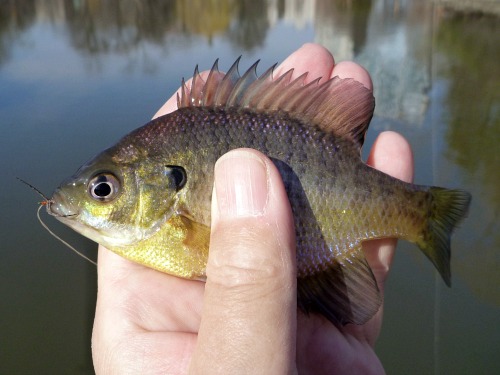
That thick looking tippet is actually two strands of horsehair twisted together. Tying a fly on an eyeless hook snelled to horsehair is not particularly difficult, but it is a lot more efficient to do it at home rather than while fishing. I had brought several casts of flies, but I didn't bring any loose flies, so my choices were pretty limited.
My best fly for the conditions was a black Killer Bugger. Being black, it was easier for fish to see against the bright sky. Being much larger than my other flies also made it easier to see. I started out with the only cast that had a black Killer Bugger as one of the three flies.
It didn't take long before I saw a crappie swirl on it. Had the water been clearer I would have seen it coming but as it was there was just a white flash and it was gone. Casting back into the same general area, I was ready the second time.
Saw the flash, set the hook, broke the horsehair tippet. There is a reason Charles Cotton wrote that your line should be two hairs nearest the hook! That thought was not universal, though. Thomas Barker, in The Art of Angling, published in 1651, suggested using only one hair. On Wednesday, I should have followed Cotton. I have caught fish larger than that crappie on a single-hair tippet, but not when I felt I needed to set the hook in a hurry or miss the fish.
I did catch two small bluegills on flies, both fairly near shore in shallow water where they were able to see my size 12 flies. None of the flies I had tied on smaller hooks drew any strikes.
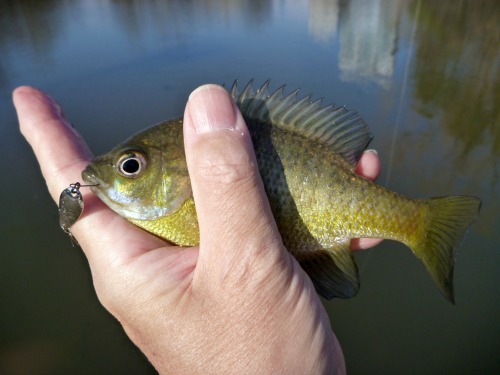
After quite a while, I finally decided that the fish probably just couldn't see the flies so I switched to something with a little flash. A regular nylon tippet and a silver .4g Daiwa Vega spoon fairly quickly attracted another bluegill.
Then, however, I remembered that the black Killer Bugger would have been more visible against the bright sky than even a silver spoon. I didn't have a black .4g spoon with me, but I did have a glossy black .8g spoon so I tied it on and gave it a go.
The first time I fished a Daiwa Vega spoon with a fixed line rod was with a TenkaraBum Traveler 39 and size 2.5 line. It was a .8g spoon, and after that one session I decided to import the .4g spoons. On Wednesday, though, with the heavier tapered horsehair line, the .8g Vega spoon cast very nicely. A heavier line will definitely smooth out the cast if you are using a heavier spoon, a heavily weighted fly or a split shot. Anglers who prefer furled lines should be able to use the .8g spoons with no problems.
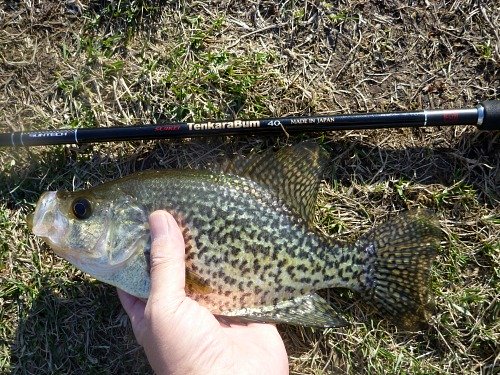
The glossy black .8g Daiwa Vega spoon did the trick! Before too long, two crappies came to hand, with the larger one shown above. Both fish chased it all the way to the shallow water, so I saw them coming.
By then, the "few hours" was up and I decided the crappie, which was the nicest I've taken in Central Park, would be a good note on which to end the day.
TenkaraBum Home > Trip Reports > Trip report 2-28-18
“The bitterness of poor quality remains long after the sweetness of low price is forgotten” - Benjamin Franklin
"Be sure in casting, that your fly fall first into the water, for if the line fall first, it scares or frightens the fish..." -
Col. Robert Venables 1662
As age slows my pace, I will become more like the heron.
Warning:
The hooks are sharp.
The coffee's hot.
The fish are slippery when wet.
Beware of the Dogma
Currently processing orders that were received Mar 8.



